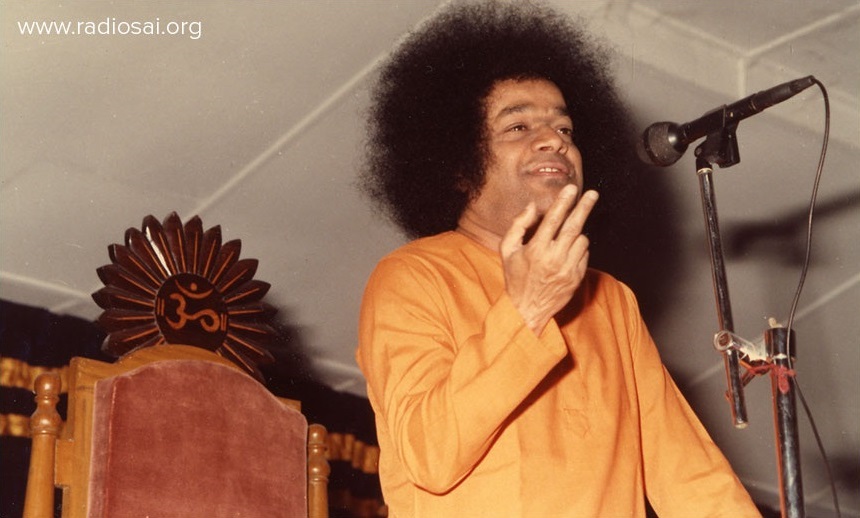
Sri Sathya Sai Speaks
Divine Discourses spanning 7 Decades (1950 – 2011)
Vidya Vahini (Download)
| |
Higher Learning
That which has no origin knows no beginning. It was before everything or anything was. There was nothing prior to It. For that very reason, It has no end. It expands as far as It wills, progresses as diverse as It feels, and, through Its fullness, fills the universe. Knowledge of this supreme principle is known as “that which illumines (vidya)” – spiritual knowledge, wisdom, awareness.
Many seers with manifold experiences of this unique awareness have visualised in their illumined hearts the sovereign secret underlying the captivating beauty of the cosmos. Compassion toward humanity has prompted them to communicate the vision through human language to arouse the innate thirst in the soul for immersion in that bliss. Spiritual learning (vidya) causes this urge in the hearts of the seers.
Vedic literature
Sound is the very core of the Veda. Sound is associated with harmony and melody, so the Veda has to be heard and ecstasy derived therefrom. It is not to be analysed, commented upon, and judged. This is why the Veda is called “that which is heard (sruthi)”. Only through listening to its recital can the awareness of the Atma and of the bliss it confers be earned. The bliss thus acquired manifests in words and deeds that confer bliss on all around.
The term Vedanta is generally used by many to indicate a school of philosophical thought. But Vedanta is only a special section of Vedic literature. All the Upanishadic texts form part of Vedanta. Vedanta is the consummation of Vedic thought. The Vedas themselves are invaluable guides toward the Highest.
The hymns (riks) of the Rig veda are ecstatic effusions from the spirit of humanity extolling the delight derived while contemplating the orderliness and beauty of nature outside them. The Sama veda is the precious verbal treasure that enables humanity to praise the Creator and His creation in song. The mystery of this world and of the worlds beyond is elaborated in the texts that are comprehensively called Atharvana veda. The formulae for rites and ceremonials – beneficial or merit-yielding or sacrificial – have been collated as the Yajur veda.
The Vedic literature grouped into these four collections – each under a different name – has four more branches: the Mantras, the Brahmanas, the Aranyakas, and the Upanishads. The mantra texts (mantra-sastra) are also called collections (samhithas), and all sacred formulae are grouped together in them.
The texts that describe the means and methods of utilising them and benefiting by their proper recital are known as Brahmanas. The word Brahma has many meanings. In the expression Brahmanas, it means mantra.
The Brahmanas deal mostly with ceremonials and kindred external activities. The Aranyakas deal with the inner significances and internal disciplines, like withdrawal of senses and elimination of attachments. The Upanishads attempt, by philosophical analysis, to harmonise the two paths. They form the final phase of Vedic studies and are called Vedanta. They can even be considered to be the essence of Vedic teachings. They are the cream of the entire Vedic scriptures. When the Vedas are assimilated by scholarship, the Upanishads emerge as butter does when milk is churned.
All forms of Vedic literature mentioned thus far form the most ancient body of knowledge, Vidya Upanishad – the word is formed by the root shad getting the two syllables upa and ni as prefixes. Shad means sitting, but it has also another meaning: destroying. Ni means steady, disciplined. Upa means near. The pupil has to sit near the guru or preceptor, paying steady attention to what is being communicated. Only then can the pupil learn the fund of knowledge and the skill of discrimination.
The Upanishads, the Brahma Sutra, and the Bhagavad Gita – these are the basic roots of Indian philosophical thought. Together, they are known as the Authentic Triad (Prasthana Thraya).
The material and non-material worlds
This material objective world becomes visible to our eyes, pleases our senses, fascinates our minds, and informs our brain. But in and through this very world, there is one reachable non-material subjective world.
When the non-material world is known, both worlds reveal themselves as partial expressions of the same indivisible consciousness (chaithanya). The two supplement each other into the one Fullness (purnam). From the Full (Parabrahma), the individual (jiva) that is its complement arises. When the individual sheds the material corpus in which it is encased, the eternal Universal Consciousness is again the one Fullness, the Parabrahma principle.
Purnam adah; purnam idam; puurnath purnam udachyathe; purnasya purnam adaya; purnam eva avasishyathe. That is full; this is full; from the Full arose the Full; when the Full is taken from the Full, only the Full remains.
Spiritual education
The education process (vidya) teaches that the cosmos is a manifestation of the Lord’s sport and nothing .
The Upanishads declare this truth thus: This world is the residence of the Lord: Isavasyam idam jagath.
Therefore, no one can entertain a sense of personal possession or even a trace of egotism. Renounce the feeling of attachment and feel the presence of the Lord everywhere. Welcome the spiritual bliss (ananda) that the Lord, as the embodiment of spiritual bliss, confers on you and experience it with thankfulness and without being bound by desire. This is the message of the sages and seers (rishis).
Give up the feelings “I” and “you”; only then can you understand the glory of that which is neither “I” nor “mine”. This does not involve your renouncing everything. The real teaching (vidya) directs that the world be dealt with as duty demands, but in a spirit of detachment, avoiding entanglement. The acid test by which an activity can be confirmed as holy or sacred is to examine whether it promotes attachment or avoids bondage. The acid test to decide whether an activity is unholy or sinful is to examine whether it arises from or promotes greed. This is the teaching, the lesson from spiritual knowledge (vidya). Intent on fulfilling your legitimate duties, you can pray to God to keep you alive for a hundred years. You will not incur blame. So, spiritual knowledge advises you to engage in activities with full understanding of their nature and consequence.
Beasts kill only other beasts. But the blind person – one who has not acquired the vision of the Atma that one is – kills oneself. And, spiritual knowledge (vidya) warns that one who commits this crime goes into fearful realms sunk in thickest night. The supreme wisdom attempts to describe the “characteristics” of Atma. Atma has no movement, but It is present everywhere. Even the gods cannot keep pace with it, however quick they are. It reveals Its presence long before we anticipate Its presence. The Atma is immutable and omnipresent. Spiritual learning (vidya) announces that it is an impossible task to determine It. When one attains the supreme wisdom (the highest level of vidya), the distinction between “opposites” – Atma and not-Atma, spiritual knowledge and ignorance (vidya and a-vidya), growth and decay (vikasa and vinasa) – fade away. Mystics and sages attained that state of higher unity, and the history of their struggles and successes is enshrined in literature through the prompting of spiritual learning (vidya). For such sages, from that transcendental level, mere ritual or textbook knowledge is as dangerous as ignorance or negative knowledge. Such sages are aware of the mysterious origins and consequences of both. They are capable of overcoming death through lower knowledge and achieving immortality through higher or spiritual knowledge.
